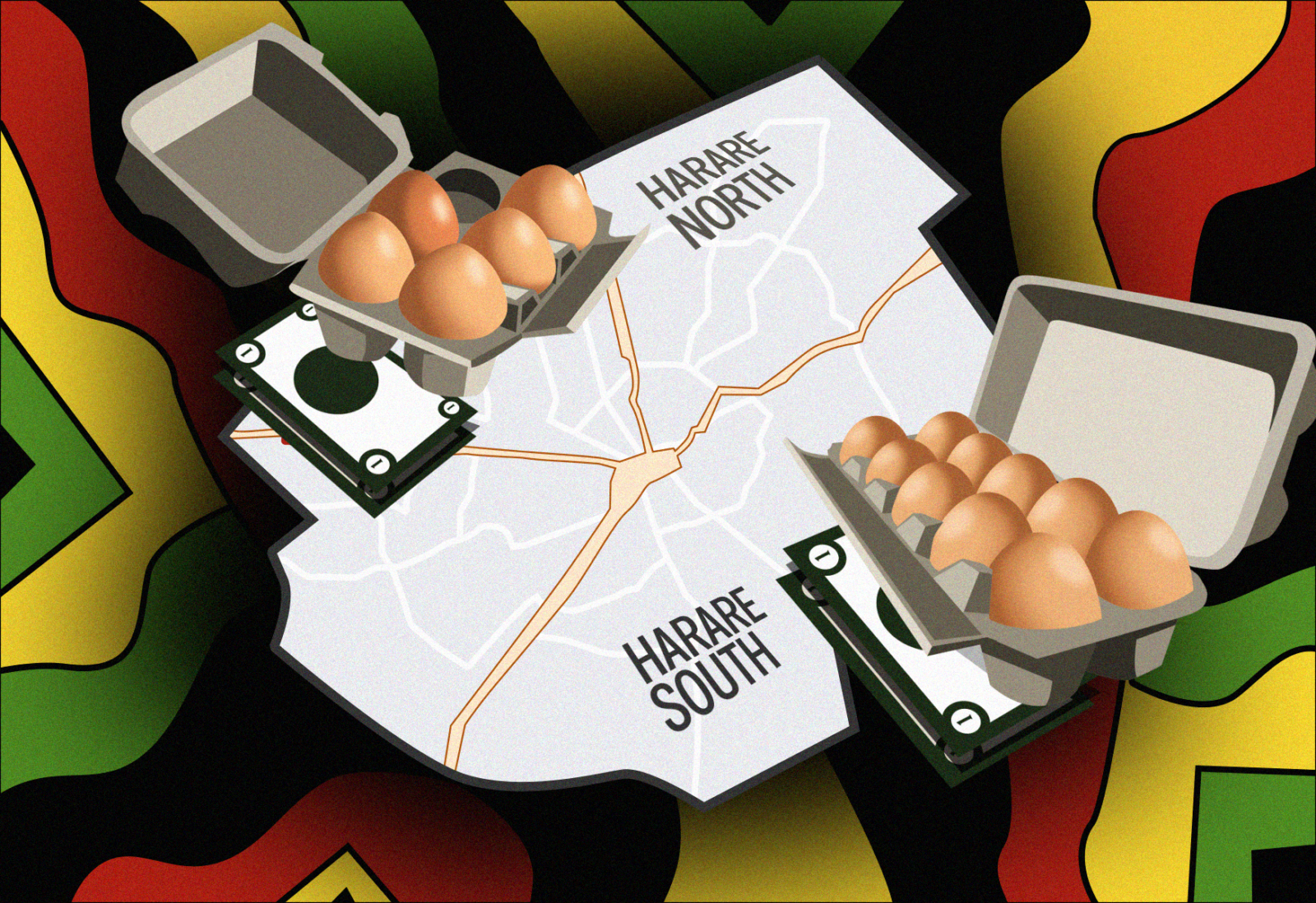Why are affluent Zimbabweans cornering shops meant for low-income families?
- In Harare, cheaper grocery prices in low income southern-lying townships are drawing wealthy shopping “migrants” from northern suburbs looking for bargains in so-called ‘poor folks’ shops.

Image description: An illustrated infographic highlights the sharp difference in prices between two suburbs in Harare, Zimbabwe: 2 dollars gets you 10 eggs in Harare South, but the same 2 dollars would get you only 5 eggs in Harare North. The illustration shows this through a gray tray of brown eggs sitting on a map. On the top side of the map is Harare North and Harare South lies at the bottom. The background is a pattern fusing colors of the Zimbabwean flag including red, yellow, green, and black.
Harare, Zimbabwe (Minority Africa) — The mid-morning Saturday sun is still weak in Stoneridge Park Township, south of Harare, Zimbabwe’s capital. Kiosk stores are already filled with smokers, bargain hunters and noisy street touts. Today is unlike weekdays when buses with city-center-bound commuters race past kiosk stores without dropping off passengers.
The sprawling township is home to Pamacongo, one of the cheap food markets in Harare, located in a low-income neighborhood where many residents supplement their food needs via home gardens. Because of this, food prices are relatively low, attracting many city dwellers.
Among these is 41-year-old Samy Jangwa, a resident of Borrowdale, Harare’s most glamorous neighborhood.
“My family lives in Borrowdale. For our staples, we drive 20 miles to forage in townships [and]food stores and restock our kitchens,” the software teacher at an upscale private school in Harare says.
This food migration began to gain steam four years ago as Zimbabwe’s inflation started climbing worryingly again after brief years of a lull.
It resulted in middle-class suburban supermarkets and food stores like SPAR, Bon Marche and those located in city-centres becoming incredibly expensive.
“Two dollars buys five eggs in Harare´s northern suburbs; two dollars fetches 10 eggs in the southern townships. Do you see this yawning gap?” Jangwa asks.
Cheaper grocery prices in low income southern-lying townships are drawing affluent shopping “migrants” from northern suburbs looking for bargains in so-called ‘poor folks’ shops. They spend several hours browsing different markets for prices before actually buying the food.
According to Daryl Nota, an economics teacher at Rusitu Theological College in eastern Zimbabwe, the differing food prices are creating arbitrage within the country. Small food kiosk owners are buying cheaper food from the low-income parts of the city and selling it for an exorbitant markup in wealthier suburbs.
“It’s some sort of interesting intercity price-gouging going on; buying a cart of oranges for $100 from the townships and selling off the cart for $150 in Harare’s nicer northern suburbs,” Nota says.
This has upset local activists like Dairi Moyo, the chairperson of Stoneridge Park Community Livelihood Association. He critiques wealthy shoppers for preventing low-income township residents from accessing formerly affordable shops.
“Townships are to serve low-income dwellers,” Moyo insists. “Posh [suburban] folks are encroaching onto our affordable food turf; restocking [their] built-in food pantries.”
Carter Mavhiza, an independent economist and public accountant in Harare, explains that middle-class shoppers from the northern suburbs get paid in US dollars because they have high-paying jobs, like IT professionals or lawyers.
They use the coveted US dollar to buy cheaper food in townships, while low-income township residents use Real Time Gross Settlement dollar (RTG) notes or mobile money to buy food.
The distinction between US dollar notes and RTG notes has created a dual pricing phenomenon. Formerly cheap township kiosks reserve high-quality beef portions or rice varieties for US dollars-paying shoppers hailing from northern suburbs.
“We see the little injustices. Sometimes choice beef steak is hidden, reserved for northern town shoppers who pay with US dollars,” says Brenda Musukutwa, a 31-year-old resident of Stoneridge Park Township.
Her viewpoint is echoed by Gladys Sinyama, a mother of two also living in Stoneridge Park Township.
“I understand that affluent shoppers with US dollar bills get preference – but for critical stuff like low-cost baby powder, I’d wish our kiosks would prioritize township mothers,” Sinyama says.
Mavhiza, on the other hand, describes this as ‘food gentrification,’ a situation in which formerly cheap food in townships is now out of the reach of residents.
Jangwa, the bargain hunter from the affluent Borrowdale suburb admits that food gentrification is an outcome of individuals sourcing foods from low income communities but he says, “This is a necessity,” adding that “With our US dollar bills we are stepping on the toes of townships residents.”
A history of biting prices
Decades of debilitating US sanctions have left Zimbabwe with the unenviable tag of being one of Africa’s expensive food destinations. Coupled with the country’s inability to pay back debts, Zimbabwe cannot borrow easily from bilateral organizations like the IMF.
O’bren Nhachi, a social scientist with the Centre for Natural Resource Governance (CNRG), explains that the US has designated Zimbabwe as a high-risk destination. According to Nhachi, this is a direct result of Zimbabwe’s domestic governance problems, which deepen its financial misery.
Consequently, private lenders from China or the Middle East, who take chances with Zimbabwe, impose excessively high-interest rates on their loans. Nhachi describes Zimbabwe as “a difficult country to lend to,” as “foreign money attracts high-interest rates which are passed down to domestic consumers.”
Musukutwa who lives in Stoneridge Park recalls a time when food prices in the township were reasonable.
Because of the economic status of the residents of these townships, kiosks supplied by local informal farmers ensured that the residents were able to purchase commodities, rendering products and services cheaper.
“Prices would stay calm for up to 12 months until posh northern suburb shoppers began to arrive,” Musukutwa explains.
The Zimbabwe government’s chaotic drive to grab white-owned commercial plantations in the early 2000s severely damaged food production and downstream industries. A further driver of high food prices is the gross corruption that consists of parceling the best farmland to ruling party elites and the pilfering of billions in taxpayers’ money under the guise of agriculture subsidies.
Urban food hunger is a troubling feature in Zimbabwe every year. In 2019, the UN Special Rapporteur on the Right to Food declared that Zimbabwe is on the cusp of man-made starvation, with 60% of the population getting by on few meals.
“US sanctions; climate disasters; the pegging of prices in US dollars; massive agricultural corruption are fueling punitive food prices in Zimbabwe,” says economics teacher, Nota.
Low food prices in Zimbabwe’s low income townships have also been attributed to demographics and municipal laws.
In Stoneridge Park, the abundance of food shops run by Congolese immigrants living in Zimbabwe, according to residents, partly explains why prices are affordable there.
“The refugee-run food shops sell us a packet of frozen chicken for just $3; however, the high street city center of Harare supermarkets offer the same chicken for $5.50,” says Gladys Sinyama, a mother of two living in Stoneridge Park Township.
Hundreds of Congolese refugees in Stoneridge Park and Township can afford to operate low-cost grocery kiosks because they receive monthly cash grants from the UN Refugee Agency (UNHCR) and business startup loans from agencies like the World Food Programme (WFP).
“We can keep our prices so low compared to northern suburbs stores because humanitarian cash grants boost us,” says Antonio Kiliwa, a Congolese refugee entrepreneur running two grocery stores in Stoneridge Park.
Farming regulations
Urban farming regulations are loosely enforced in Harare’s poorer townships. In places like Mabvuku or Stoneridge Park, fields of arable land are aggressively farmed by low-income residents who grow rice, maize, cabbages, vegetables or tomatoes.
The same fallow land is packed with pens for raising poultry and even goats.
Lancet Mhlanga, an entrepreneur gardener and goats breeder, speculates that the authorities tolerate urban farming in low-income areas as urban gardens assist with combating food insecurity.
Whereas, in wealthy suburbs, like Borrowdale in Northern Harare, urban farming is frowned upon and clamped down on by municipal officers.
“By-law officers get tough on anyone wanting to farm open spaces. The assumption is if you live in northern suburbs you can afford posh supermarket food,” says Nota.
In Mabvuku Township, kiosk owners source a large amount of their produce from urban farming. The maize grown in its own spaces and poultry raised in backyards means that food kiosks can be supplied with cheaper food. Points out that while agricultural activities among informal growers might not be licensed, it does help to keep township prices low.
The contrast is visible with wealthy suburbs, where supermarkets often have to import food from South Africa and put a markup on the products.
“It’s better to farm abandoned open lands than sleep on hunger because supermarket foods are costly,” says Mhlanga.
Samy Jangwa is conflicted about urban dwellers like himself cornering cheaper township shops ‘reserved’ for poorer residents, but he says this is a matter of pragmatism.
As for Musukutwa, she wants township stores to stop demanding US dollar bills and insists that the RTGS Zimbabwe currency is at par with the US dollar.
Jangwa would also like to see a variety of shops set up in posh northern suburbs with some offering the affordable prices found in townships and thus stem the migration of the middle-class to hunt for bargains in townships.
“Middle-class northern suburbs or township dwellers, we are all Zimbabweans united by one need – lower grocery prices,” he says.
Edited by Cassandra Roxburgh, PK Cross, Caleb Okereke, and Uzoma Ihejirika.
Kudakwashe Magezi is a freelance journalist from Zimbabwe, essayist and poet. His writing has appeared in Daily Maverick South Africa, The New Arab, Rest of World and The New Internationalist. His focus topics are culture and economics.






